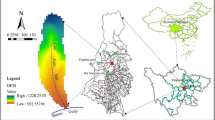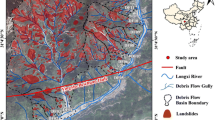Abstract
Debris-flow disasters occurred frequently after the Mw 8.0 Wenchuan earthquake on 12 May 2008 in Sichuan Province, China. Based on historical accounts of debris-flow disaster events, it found that debris flow occurrence is closely related to the impact of earthquakes and droughts, because earthquake-drought activities can increase the loose solid materials, which can transform into debris flows under the effect of rainstorms. Based on the analysis of historical earthquake activity (frequency, magnitude and location), drought indexes and the trend of climate change (amount of rainfall), a prediction method was established, and the regional debris flow susceptibility was predicted. Furthermore, in a debris flow-susceptible site, effective warning and monitoring are essential not only from an economic point of view but are also considered as a frontline approach to alleviate hazards. The advantages of the prediction and early monitoring include (1) the acquired results being sent to the central government for policy making; (2) lives and property in mountainous areas can be protected, such as the 570 residents in the Aizi valley, who evacuated successfully before debris flows in 2012; (3) guiding the government to identify the areas of disasters and the preparation for disaster prevention and mitigation, such as predicting disasters in high-risk areas in the period 2012–2017, hel** the government to recognize the development trend of disasters; (4) the quantitative prediction of regional debris-flow susceptibility, such as after the Wenchuan earthquake, can promote scientific and sustainable development and socioeconomic planning in earthquake-struck areas.
Similar content being viewed by others
References
Cama M, Lombardo L, Conoscenti C, et al. (2017) Improving transferability strategies for debris flow susceptibility assessment: Application to the Saponara and Itala catchments (Messina, Italy). Geomorphology 288: 52–65. https://doi.org/10.1016/j.geomorph.2017.03.025
Chang TC, Wang ZY, Chien YH (2010) Hazard assessment model for debris flow prediction. Environmental Earth Sciences 60(8): 1619–1630. https://doi.org/10.1007/s12665-009-0296-x
Chen N, Li J, Liu L, Liu M, et al. (2018) Post-earthquake denudation and its impacts on ancient civilizations in the Chengdu Longmenshan region, China. Geomorphology 309: 51–59. https://doi.org/10.1016/j.geomorph.2018.02.007
Chen NS, Deng MF, Hu GS, et al. (2010) Risk characteristics and prevention strategy of debris flow under the seismic influence in mountainous arid area, Southwest China. Journal of Sichuan University 42: 1–6. (In Chinese)
Chen NS, Lu Y, Zhou HB, et al. (2014) Combined impacts of antecedent earthquakes and droughts on disastrous debris flows. Journal of Mountain Science 11: 1507–1520. https://doi.org/10.1007/s11629-014-3080-7
Chen NS, Zhou W, Yang CL, et al. (2010) The processes and mechanism of failure and debris flow initiation for gravel soil with different clay content. Geomorphology 121: 222–230. https://doi.org/10.1016/j.geomorph.2010.04.017
Cheng D, Cui YF, Su FH, et al. (2018) The characteristics of the Mocoa compound disaster event, Colombia Landslides 6: 1–10. https://doi.org/10.1007/s10346-018-0969-1
Wang DJ, Cui P, Zhu B (2004) Vegetation rehabilitation techniques and ecological effects in dry-hot valley of **sha River-case study in **aojiang basin, Yunnan Province. Journal of Soil Water Conservation 18(5): 95–98 (In Chinese)
Ellen SD (1988) Description and mechanics of soil slip/debris flows in the storm. In Landslides, Floods and Marine Effects of the Storm of the January 3–5, 1982, in the San Francisco Bay Region, California; USGS Professional Paper; U.S. Geological Survey: Washington, DC, USA; Denver, CO, USA.
Elmore AJ, Manning SJ, Mustard JF et al. (2006) Decline in Alkali Meadow vegetation cover in California: The effects of groundwater extraction and drought. Journal of Applied Ecology 43(4): 770–779. https://doi.org/10.2307/3838433
Florsheim JL, Chin A, Kinoshita AM, et al. (2017) Effect of storms during drought on post-wildfire recovery of channel sediment dynamics and habitat in the southern California chaparral, USA. Earth Surface Processes and Landforms 42: 1482–1492. https://doi.org/10.1002/esp.4117
Gao YJ, Chen NS, Hu GS, et al. (2018) Temporal and spatial coupling relationship between debris flow and El Nino-La Nina event in Southwest China. Journal of Yangtze River scientific research institute 1–5. (In Chinese)
Guthrie RH, Hockin A, Colquhoun L, et al. (2010) An examination of controls on debris flow mobility: Evidence from coastal British Columbia. Geomorphology 114(4): 601–613. https://doi.org/10.1016/j.geomorph.2009.09.021
He N, Yang JY, Chen NS, et al. (2013) Study on the causes of “6.28” Aizi gully extra large debris flow disasters. Journal of Disaster Prevention & Mitigation Engineering 6: 671–678. (In Chinese)
Hu GS, Chen NS, Iqbal TJ, et al. (2017) Debris flow susceptibility analysis based on the combined impacts of antecedent earthquakes and droughts: a case study for cascade hydropower stations in the upper Yangtze River, China. Journal of Mountain Science 14: 1712–1727. https://doi.org/10.1007/s11629-017-4375-1
Hungr O (2005) Debris-flow hazards and related phenomena. Springer Berlin Heideger, Berlin 9–23. https://doi.org/10.1007/3-540-27129-5_2
Ikeya H (1989) Debris flow and its countermeasures in Japan. Bulletin of Engineering Geology and the Environmen 40(1): 15–33. https://doi.org/10.1007/BF02590339
Irmler R, Daut G, Mäusbacher R (2006) A debris flow calendar derived from sediments of lake Lago di Braies (N. Italy). Geomorphology 77: 69–78. https://doi.org/10.1016/j.geomorph.2006.01.013
Iverson RM (1997) The physics of debris flows. Reviews of Geophysics 35: 245–296. https://doi.org/10.1029/97rg00426
Kang S, Lee SR (2018) Debris flow susceptibility assessment based on an empirical approach in the central region of South Korea. Geomorphology 308: 1–12. https://doi.org/10.1016/j.geomorph.2018.01.025
Kessler JLP, Soreghan GS, Wacker HJ (2001) Equatorial Aridity in Western Pangea: Lower Permian Loessite and Dolomitic Paleosols in Northeastern New Mexico, U.S.A. Journal of Sedimentary Research 71: 817–832. https://doi.org/10.1306/2DC4096B-0E47-11D7-8643000102C1865D
Sass O, Krautblatter M (2007) Debris flow-dominated and rockfall-dominated talus slopes: Genetic models derived from GPR measurements. Geomorphology 86(1–2): 0–192. https://doi.org/10.1016/j.geomorph.2006.08.012
Seiler RA, Hayes M, Bressan L (2002) Using the standardized precipitation index for flood risk monitoring. International Journal of Climatology 22(11): 1365–1376. https://doi.org/10.1002/joc.799
Sepúlveda SA, Rebolledo S, Vargas G (2006) Recent catastrophic debris flows in Chile: geological hazard, climatic relationships and human response. Quaternary International 158(1): 83–95. https://doi.org/10.1016/j.quaint.2006.05.031
Sheffield J, Wood EF (2006) Global Trends and variability in soil moisture and drought characteristics, 1950–2000, from observation-driven simulations of the terrestrial hydrologic cycle. Journal of Climate 21: 432–458. https://doi.org/10.1175/2007jcli1822.1
Tang C, Zhu J, Li WL, Liang JT (2009) Rainfall-triggered debris flows following the Wenchuan earthquake. Bulletin of Engineering Geology and the Environment 68: 187–194. https://doi.org/10.1007/s10064-009-0201-6
Sæmundsson Þ, Morino C, Helgason JK, et al. (2018) The triggering factors of the Móafellshyrna debris slide in northern Iceland: Intense precipitation, earthquake activity and thawing of mountain permafrost. Science of the Total Environment 621: 1163. https://doi.org/10.1016/j.scitotenv.2017.10.111
Turkington T, Remaltre A, Ettema J, et al. (2016) Assessing debris flow activity in a changing climate. Climatic Change 137(1–2): 293–305. https://doi.org/10.1007/s10584-016-1657-6
Wang J, Yan YU, Ou GQ, et al. (2016) Study on the geotechnical mechanical characteristics of loose materials in the Wenchuan earthquake-hit Areas. Science Technology & Engineering 5: 11–18. (In Chinese)
Wei Z, Shang Y, Zhao Y, et al. (2017) Rainfall threshold for initiation of channelized debris flows in a small catchment based on in-site measurement. Engineering Geology 217: 23–34. https://doi.org/10.1016/j.enggeo.2016.12.003
Wei ZL, Xu YP, Sun HY, et al. (2018) Predicting the occurrence of channelized debris flow by an integrated cascading model: A case study of a small debris flow-prone catchment in Zhejiang Province, China. Geomorphology 308: 78–90. https://doi.org/10.1016/j.geomorph.2018.01.027
Yu YX (2006) Attenuation Relations for Horizontal Peak Ground Acceleration and Response Spectrum in Eastern and Western China. Technology for Earthquake Disaster Prevention 1(3): 206–217. (In Chinese)
Zhang S, Zhang LM (2017) Impact of the 2008 Wenchuan earthquake in China on subsequent long-term debris flow activities in the epicentral area. Geomorphology 276: 86–103. https://doi.org/10.1016/j.geomorph.2016.10.009
Zhao A, Zhang A, Cao S, et al. (2018) Responses of vegetation productivity to multi-scale drought in Loess Plateau, China. CATENA 163: 165–171. https://doi.org/10.1016/j.catena.2017.12.016
Zhao ZQ, Cai YL, Fu MC, Bai ZK (2008) Response of the soils of different land use types to drought: Eco-physiological characteristics of plants grown on the soils by pot experiment. Ecological Engineering 34(3): 215–222. https://doi.org/10.1016/j.ecoleng.2008.08.003
Zhu J, Ding J, Liang JT (2011), Influences of the Wenchuan Earthquake on sediment supply of debris flows. Journal of Mountain Science 8: 270–277. https://doi.org/10.1007/s11629-011-2114-7
Acknowledgements
This research was funded by National Natural Science Foundation of China (Grant No. 41671112 and 41861134008), National Key Research and Development Plan (Grant No. 2018YFC1505202) and Sichuan Province Science and Technology Plan Project Key research and development projects (Grant No. 18ZDYF0329). Finally, the authors wish to express their gratitude to anonymous reviewers and editor for their valuable comments that substantially improved this paper.
Author information
Authors and Affiliations
Corresponding author
Rights and permissions
About this article
Cite this article
Chen, Ns., Zhang, Y., Tian, Sf. et al. Effectiveness analysis of the prediction of regional debris flow susceptibility in post-earthquake and drought site. J. Mt. Sci. 17, 329–339 (2020). https://doi.org/10.1007/s11629-019-5684-4
Received:
Revised:
Accepted:
Published:
Issue Date:
DOI: https://doi.org/10.1007/s11629-019-5684-4




